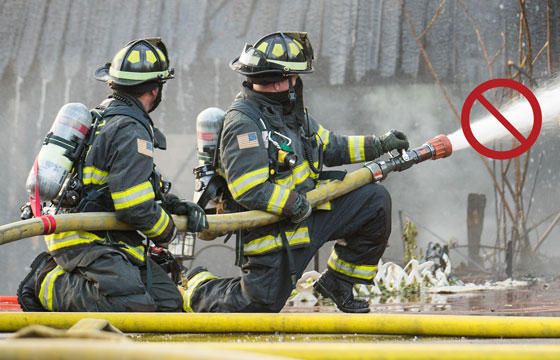| View in browser > |
 |
| Never spray water on flames from gas pipes |
|
Spraying water into natural gas pipelines can have devastating and potentially deadly consequences. This action not only heightens risks at the fire scene, but it can also flood gas piping, knock out pilot lights and lead to a serious gas accumulation problem downstream. Learn about the risks of spraying water on flames that originate from natural gas pipes – and what to do instead. |
|
|
 |
|
| Extinguishing gas fires increases explosion risks |
| Applying water to extinguish a fire that originates from a natural gas pipe can increase explosion risks at the incident scene and beyond. |
| Water cannot stop the flow of gas. Although it may extinguish some flames, the gas will continue flowing under pressure from the pipe, providing a continuous supply of new fuel. Water will create steam while the gas continues escaping. |
| Extinguishing gas‑fed flames creates an invisible hazard. Natural gas is lighter than air and rapidly rises when released, migrating into upper floors, attics and other spaces some distance from the original leak site. This unburned gas can collect in enclosed areas and find numerous ignition sources, creating multiple zones with explosive potential. This presents a far greater danger than the original controlled flame. (While natural gas is burning, it cannot explode.) |
| Introducing water into gas pipes causes widespread hazards |
| Water that is sprayed on a broken gas line can enter a gas main and flow downhill through the distribution system, creating extensive service disruption and dangerous explosion risks in locations far from the original incident. Here’s how it happens: |
| • |
 |
Water that enters a gas pipeline creates pockets that block or restrict gas flow. Gas pressure can build up behind these water blockages and when the water eventually clears, the accumulated gas surge can overwhelm pressure regulators, create excessive flow at customer appliances, flood buildings with unburned gas and extinguish pilot lights while simultaneously releasing gas. |
|
| • |
 |
A gas surge can affect buildings far from the original incident, creating multiple hazard zones that are difficult to predict or control. First responders may be unaware of these developing secondary hazards and customers may be unaware of the danger as gas accumulates. |
|
|
| Water intrusion in gas pipes can also have long‑term impacts on the gas distribution system. Restoring service after water intrusion requires extensive purging operations, and each affected customer appliance must be individually relit. Water intrusion can also create corrosion issues in steel gas pipes. |
| What to do instead: |
|
|
| • |
 |
Let it burn! Always allow a natural gas fire to burn until the gas can be shut off at the source. When the gas supply is depleted, the fire will go out on its own. Maintain a safe perimeter based on the size of the flame and monitor flame characteristics for changes that might indicate problems. |
| • |
 |
Shut off gas safely. For structure fires, you may shut off burning gas by closing the shutoff valve located aboveground before a service meter or on the supply line of an appliance, provided you have been trained to do so. Never attempt to bend or crimp lines as an emergency shutoff. |
|
| ⚬ |
 |
If you shut off a gas service meter, leave it off. Only National Grid personnel can turn the gas back on. |
|
| ⚬ |
|
NEVER attempt to close valves on underground gas pipelines or relief valves. These valves should only be operated by trained National Grid personnel. |
|
|
|
| • |
 |
Use a fog spray to protect exposures. You may use a fog spray to cool combustible exposures if it is safe to do so. You may also use water to extinguish all open flames not originating from a gas pipe. Coordinate multiple lines for effective coverage and maintain adequate distance to avoid steam burns. |
 |
| • |
|
Use water for rescue and cooling. During rescue operations, you may use multiple overlapping fog streams to protect the rescue team from the intense heat of burning gas and to direct the body of the fire. DO NOT use solid or straight stream nozzles on or near any natural gas pipe. |
 |
|
|
|
| • |
 |
Remain alert for re‑ignition. Once the fire has been controlled, remain alert for gas migration and possible re-ignition in nearby structures. |
|
| Keep yourself, your team and the public safe this spring and year‑round. Visit firstresponder.ngridsafety.com today to register and complete your FREE utility safety training. |
|
|
|
| |
| |
|
| To report emergencies, call 911 and National Grid immediately. |
| |
 |
| In case of gas emergencies: |
 |
Long Island and the Rockaways:
911 and 1‑800‑490‑0045 |
 |
Metro New York:
911 and 1‑718‑643‑4050 |
 |
Upstate New York:
911 and 1‑800‑892‑2345 |
 |
Massachusetts:
911 and 1‑800‑233‑5325 |
 |
| |
|
|
|
|
| |
|
|
|
| |
| |
|
 |
#17655 © 2025 Culver Media, LLC |
|
| |
|
|
|
 |
|
| |
| |